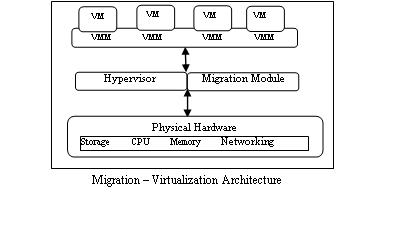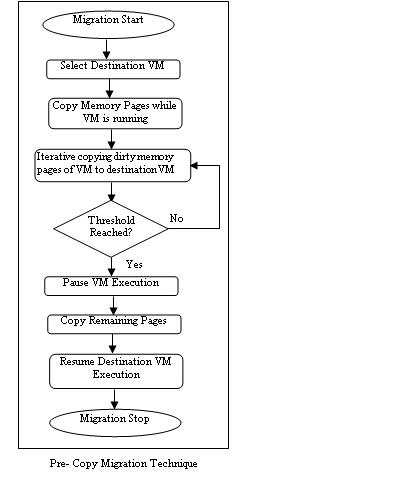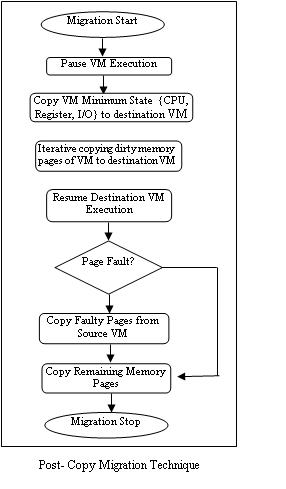Virtual Machine Migration
This section provides the technologies of virtual machine migration with its execution procedures. Basically it is the process of migrate a virtual machine from one host to another. It also has the capability to move workload of multiple running virtual machines on a single physical machine. The main difference between virtualization and virtual machine migration is that only migration module is inculcate with hypervisor. The architecture of virtual machine migration virtualized platform is shown in figure:

Although, the process of migration has been initiated in 1980, but it was used often-ally, due to its main limitation i.e. how to handle interaction between various modules of operating system. But it overcomes in virtual machine migration because it moves the whole operating system along with running processes. VM migration becomes this process simplified and efficient. It also takes care of load balancing, energy consumption, workload consolidation etc. Henceforth, it becomes more popular and wide adoption in industry. Below table describes the types of VM migrations.
|
VM Migration Type |
Description |
|
Cold Migration |
Before migration, the virtual machine must be powered off, after doing this task. The old one should be deleted from source host. Moreover, the virtual machine need not to be on shared storage. |
|
Warm Migration |
Whenever transfer OS and any application, there is no need to suspend the source host. Basically it has high demand in public cloud. |
|
Live Migration |
It is the process of moving a running virtual machine without stopping the OS and other applications from source host to destination host. |
Techniques of VM Migration
This subsection describes the types of virtual machine migration techniques. It is basically of two types:
- Pre- Copy Migration
- Post-Copy Migration
Pre- Copy Migration: In this migration, the hypervisor copies all memory page from source machine to destination machine while the virtual machine is running. It has two phases: Warm- up Phase and stop and copy phase.
Warm Up Phase: During copying all memory pages from source to destination, some memory pages changed because of source machine CPU is active. All the changed memory paged known as dirty pages. All these dirty pages are required to recopy on destination machine; this phase is called as warm up phase.
Stop & Copy Phase: Warm up phase is repeated until all the dirty pages recopied on destination machine. This time CPU of source machine is deactivated till all memory pages will transfer another machine. Ultimately at this time CPU of both source and destination is suspended, this is known as down time phase. This is the main thing that has to explore in migration for its optimization.
Post- Copy Migration: In this technique, VM at the source is suspended to start post copy VM migration. When VM is suspended, execution state of the VM (i.e. CPU state, registers, non-pageable memory) is transferred to the target. In parallel the sources actively send the remaining memory pages of the VM to the target. This process is known as pre-paging. At the target, if the VM tries to access a page that has not been transferred yet, it generates a page fault, also known as network faults. These faults are redirect to the source, which responds with the faulted pages. Due to this, the performance of applications is degrading with number of network faults. To overcome this, pre-paging scheme is used to push pages after the last fault by dynamically using page transmission order. Figure 3 & 4 shows the pre copy and post copy migration technique respectively.







